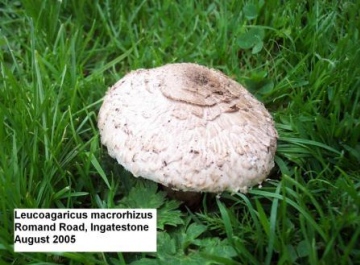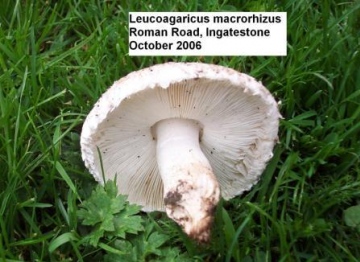This is a relatively easy species to identify, the large (up to 8cm), white to pale grey, radially fibrillose (almost shaggy) cap surface; thin, removable ring (just about distinguisable on the photo) and tapered stem all being characteristic. The spores measure 6-10um and are without a germ pore.
The Checklist (2005) states that it is found on soil in cool greenhouses; also in gardens, urban streets, and on dunes. It is rare, having been recorded at that time from only seven English counties, South Essex among them. However, I could not find the last named record on the BMS online database. There was, however, an article in the EN newsletter a few years ago describing this species from a similar habitat at Writtle.
December 5th Postscript : At the Club Exhibition at Chelmsford yesterday Tony Boniface mentioned that, thanks to the Club's new archive, it is now easy to look up long ago, half remembered records such as the Leucoagaricus barsii record at Writtle mentioned above. This morning I did so, typing in Lecoagaricus macrorhiza (its old name) and, wallah, there it was in the relevant newsletter displayed before me : found by the late Stan Hudgell, identified by Tony himself, and confirmed by Alec Henrici at Kew. At the time it was only the third record for Britain. My apologies to Tony for not remembering that it was him who wrote up the original record but full marks to the new archive. I only wish I had as much luck with Kew as he does; it is something of a black hole with regards to most of the specimens I have sent them!



















